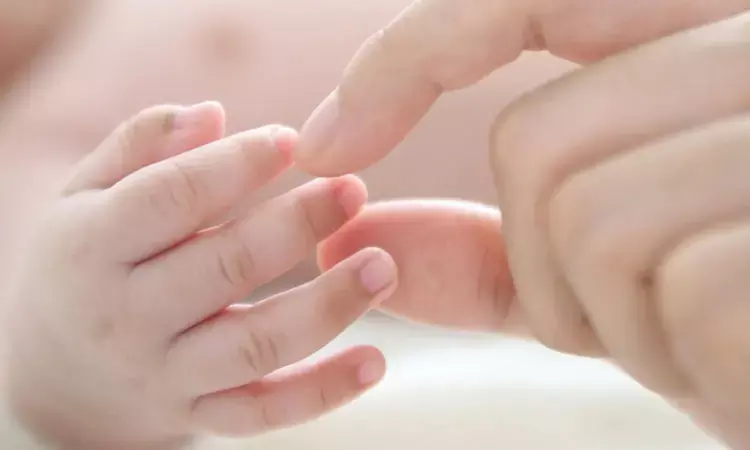- Home
- Medical news & Guidelines
- Anesthesiology
- Cardiology and CTVS
- Critical Care
- Dentistry
- Dermatology
- Diabetes and Endocrinology
- ENT
- Gastroenterology
- Medicine
- Nephrology
- Neurology
- Obstretics-Gynaecology
- Oncology
- Ophthalmology
- Orthopaedics
- Pediatrics-Neonatology
- Psychiatry
- Pulmonology
- Radiology
- Surgery
- Urology
- Laboratory Medicine
- Diet
- Nursing
- Paramedical
- Physiotherapy
- Health news
- Fact Check
- Bone Health Fact Check
- Brain Health Fact Check
- Cancer Related Fact Check
- Child Care Fact Check
- Dental and oral health fact check
- Diabetes and metabolic health fact check
- Diet and Nutrition Fact Check
- Eye and ENT Care Fact Check
- Fitness fact check
- Gut health fact check
- Heart health fact check
- Kidney health fact check
- Medical education fact check
- Men's health fact check
- Respiratory fact check
- Skin and hair care fact check
- Vaccine and Immunization fact check
- Women's health fact check
- AYUSH
- State News
- Andaman and Nicobar Islands
- Andhra Pradesh
- Arunachal Pradesh
- Assam
- Bihar
- Chandigarh
- Chattisgarh
- Dadra and Nagar Haveli
- Daman and Diu
- Delhi
- Goa
- Gujarat
- Haryana
- Himachal Pradesh
- Jammu & Kashmir
- Jharkhand
- Karnataka
- Kerala
- Ladakh
- Lakshadweep
- Madhya Pradesh
- Maharashtra
- Manipur
- Meghalaya
- Mizoram
- Nagaland
- Odisha
- Puducherry
- Punjab
- Rajasthan
- Sikkim
- Tamil Nadu
- Telangana
- Tripura
- Uttar Pradesh
- Uttrakhand
- West Bengal
- Medical Education
- Industry
Case Report Highlights Risks of Iatrogenic Hypospadias Following Traditional Circumcision in Young Child

Somalia: A recent case report published in the Annals of Medicine and Surgery has brought attention to the risks associated with traditional circumcision, particularly the potential for iatrogenic hypospadias. This condition, characterized by an abnormal opening of the urethra on the underside of the penis, can have significant implications for a patient’s health and quality of life.
Traditional circumcisions may cause complications such as hemorrhage, infection, amputations of the penis, meatal stenosis, and urethro-cutaneous fistula. In addition to all these complications, iatrogenic hypospadias, as in our case, is a rare condition. In general, complications are mild and preventable, especially in children, but when the procedure is carried out by unskilled providers, in unsterile conditions, or with inadequate equipment and supplies, severe complications are more likely to occur. Several degrees of urethral erosion, including iatrogenic hypospadias, might result from further injury. Particularly in intensive care facilities, the ventral male urethra can undergo this kind of trauma.
The case described involves a 4-year-old child who underwent circumcision at the age of 3 and subsequently experienced significant bleeding. Four months later, his parents took him to the hospital. Upon examination, the glans appeared normal, but there was an opening near the glans at the distal urethra, located at the subcoronal level.
After a thorough pre-operative evaluation, the child was prepared for elective surgery. During the procedure, an incision was made to expose the fistula tract, with marker sutures placed around the edges for guidance. The fistula opening was then repaired using 6/0 PDS (polydioxanone) sutures, and a second layer was created over the repair before closing the skin with 4/0 Vicryl (polyglactin) sutures.
Shukri Said Mohamed, Mogadishu Somali Turkey Recep Tayyip Erdoğan Training and Research Hospital, Mogadishu, Somalia, and colleagues emphasize that circumcision remains the most commonly performed procedure on children worldwide. However, injuries to the penis can occur, with a complication rate of approximately 1%. One of the leading causes of fistulas is a poorly placed suture at the frenulum, which aims to achieve hemostasis. This can result in strangulation and necrosis of part of the urethral wall, ultimately leading to the formation of a sub-glandular fistula. Prompt identification and treatment of any potentially life-threatening injuries to the urethra are crucial.
The authors conclude that circumcision, as a medical procedure, requires careful execution and should only be performed by qualified surgeons in sterile hospital environments. Most injuries associated with circumcision occur during clamp procedures, such as Mogen or Gomco, and can vary in severity from minor loss of penile skin to more severe injuries affecting the glans, distal urethra, or penile shaft.
Reference:
Mohamed SS, Sheikh OA, Adam MK, Ali AY, Mohamed AH, Mead A. A presentation of iatrogenic hypospadias after traditional circumcision: A case report. Ann Med Surg (Lond). 2022 Nov 12;84:104872. doi: 10.1016/j.amsu.2022.104872. PMID: 36582869; PMCID: PMC9793154.
Dr Kamal Kant Kohli-MBBS, DTCD- a chest specialist with more than 30 years of practice and a flair for writing clinical articles, Dr Kamal Kant Kohli joined Medical Dialogues as a Chief Editor of Medical News. Besides writing articles, as an editor, he proofreads and verifies all the medical content published on Medical Dialogues including those coming from journals, studies,medical conferences,guidelines etc. Email: drkohli@medicaldialogues.in. Contact no. 011-43720751


